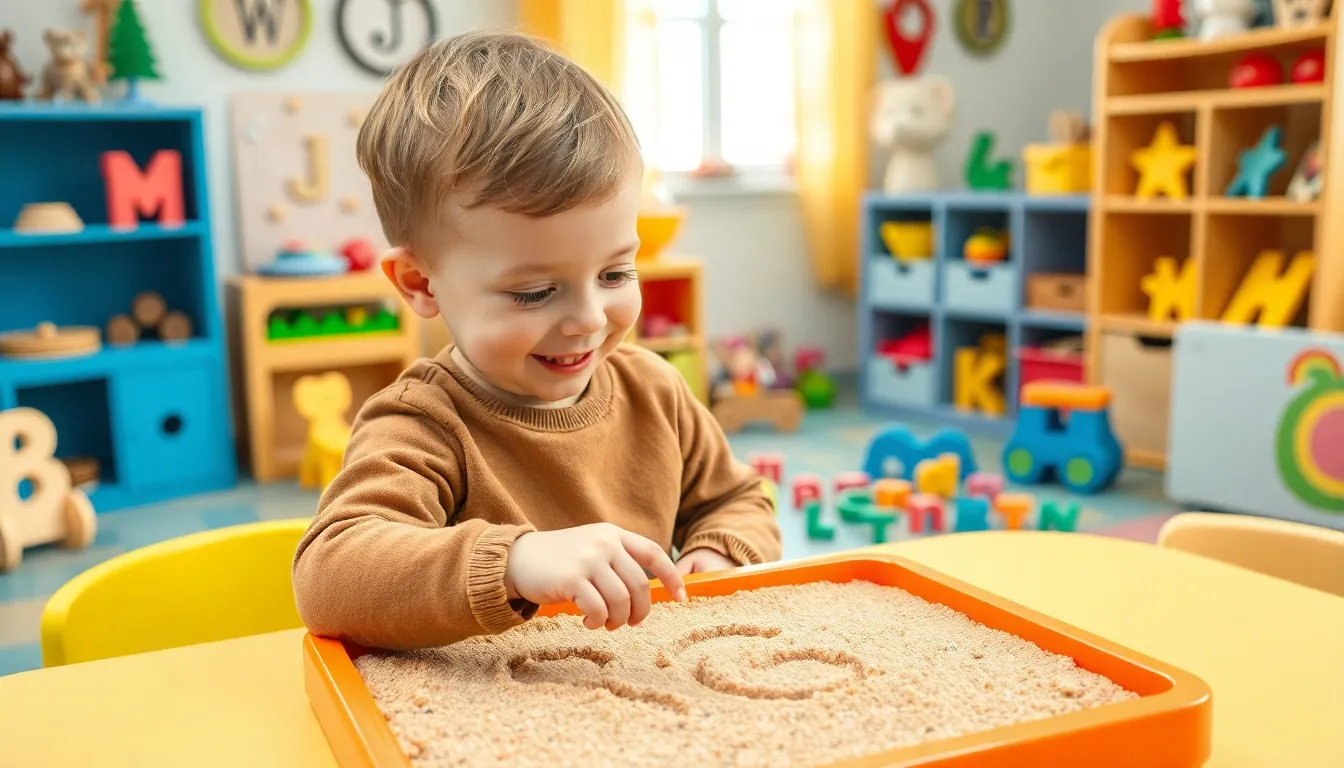Teaching toddlers the art of letter tracing can be a delightful adventure. Imagine tiny fingers wiggling and squiggling as they navigate the curves and lines of the alphabet. It’s not just about writing; it’s a playful journey that builds confidence and fine motor skills. Plus, who doesn’t want to see their little one proudly displaying their first “A” or “B” like it’s a masterpiece?
Table of Contents
ToggleBenefits of Letter Tracing for Toddlers
Letter tracing offers numerous advantages for toddlers, promoting both learning and enjoyment in their early development. Engaging in this activity supports various skills that are foundational for future learning.
Fine Motor Skills Development
Fine motor skills development occurs through repetitive tracing motions. Each stroke enhances hand-eye coordination, making tasks easier for toddlers as they progress. Children grasp writing instruments and learn to control their movements, refining their dexterity. Tracing letters engages small muscles in the hands, fingers, and wrists. Mastering these skills sets a solid foundation for writing and other tasks requiring motor precision.
Handwriting Preparation
Handwriting preparation benefits significantly from early letter tracing. Children develop muscle memory for letter shapes as they trace. Familiarity with letter formations promotes recognition and recall when writing independently. Engaging in tracing allows toddlers to understand the directionality of letters, contributing to proper writing habits. Practicing this way builds confidence, as children see immediate results from their efforts. They become more eager to explore writing, fostering a positive attitude towards learning.
Engaging Activities for Letter Tracing

Engaging activities make letter tracing enjoyable for toddlers. These hands-on experiences foster creativity while reinforcing foundational skills.
Tracing with Finger Paints
Using finger paints adds excitement to the tracing process. Toddlers enjoy the tactile sensation of painting while they learn. Begin by encouraging them to trace letters in vibrant colors, stimulating both sight and touch. This activity enhances their fine motor skills as they control finger movements. Messy play can lead to laughter, making learning more fun. Plus, cleanup becomes a shared activity, promoting collaboration and responsibility.
Flashcards and Worksheets
Flashcards present a visual and interactive way to support letter tracing. Using colorful images paired with letters captures attention effectively. Parents and caregivers can encourage toddlers to trace letters on flashcards, enhancing recognition skills. Simple worksheets reinforce this learning by offering structured tracing patterns. Repetition through various flashcards and worksheets builds confidence. Combining visuals with written letters helps with understanding shape and directionality.
Tools and Resources for Letter Tracing
Finding effective tools and resources enhances the experience of letter tracing for toddlers. These materials support young learners in developing essential skills while keeping the activity fun.
Printable Tracing Sheets
Printable tracing sheets serve as valuable tools for practicing letters. Various online educational resources offer free and customizable templates, allowing parents and educators to choose letters according to the child’s progress. These sheets often feature dashed or dotted lines, guiding toddlers in the proper formation of each letter. Engaging them with vibrant designs can capture their attention and motivate them to practice further. Parents can also laminate sheets for repeated use, making learning both eco-friendly and cost-effective.
Educational Apps
Educational apps provide interactive platforms for letter tracing. Many apps feature engaging animations and sounds, making the process enjoyable for toddlers. These applications often incorporate gamification elements, such as rewards and levels, to encourage consistent practice. Users can find a multitude of options that focus on different aspects of letter formation, enhancing both understanding and retention. Accessibility to these apps on mobile devices allows toddlers to learn letter tracing anytime and anywhere, promoting a flexible learning environment.
Tips for Parents and Educators
Creating an engaging atmosphere enhances letter tracing for toddlers.
Creating a Fun Learning Environment
A colorful workspace captures attention and inspires creativity. Surrounding children with letters in various forms makes learning alive. Incorporating playful elements, such as letter-themed toys or decorations, adds excitement. Activities integrating movement, like tracing letters in sand or with finger paints, enhance engagement. Celebrating small milestones, like successfully tracing a letter, reinforces achievements and keeps motivation high. Making learning a shared experience through games or group activities fosters collaboration among peers.
Encouraging Practice and Consistency
Establishing a consistent routine benefits toddlers’ tracing skills. Dedicating short, regular sessions for letter tracing fosters familiarity and comfort. Using diverse materials like chalkboards or apps keeps practice fresh and enjoyable. Offering praise and encouragement helps build confidence and reinforces effort. Setting achievable goals, such as mastering one letter a week, allows for gradual progress. Accessing printable resources at home and on the go supports continuous learning. Engaging toddlers in fun tracing activities consistently prepares them for future handwriting success.
Letter tracing for toddlers is a delightful journey that blends fun with essential skill development. By engaging in this hands-on activity, children not only learn the shapes of letters but also enhance their fine motor skills and build confidence in their writing abilities. The use of creative tools and interactive resources makes the learning process enjoyable and effective.
Parents and educators play a crucial role in fostering a supportive environment that encourages exploration and creativity. By celebrating achievements and maintaining consistency, they can inspire a love for learning that lasts a lifetime. Embracing letter tracing as a foundational activity sets the stage for future success in writing and literacy.



